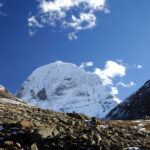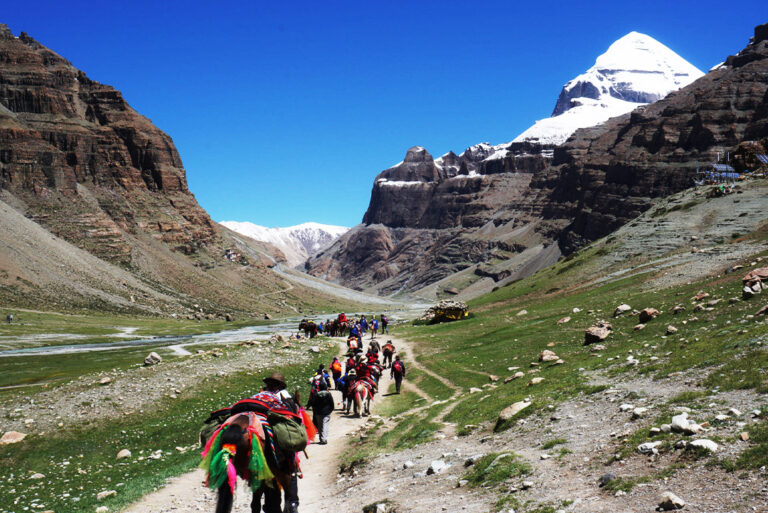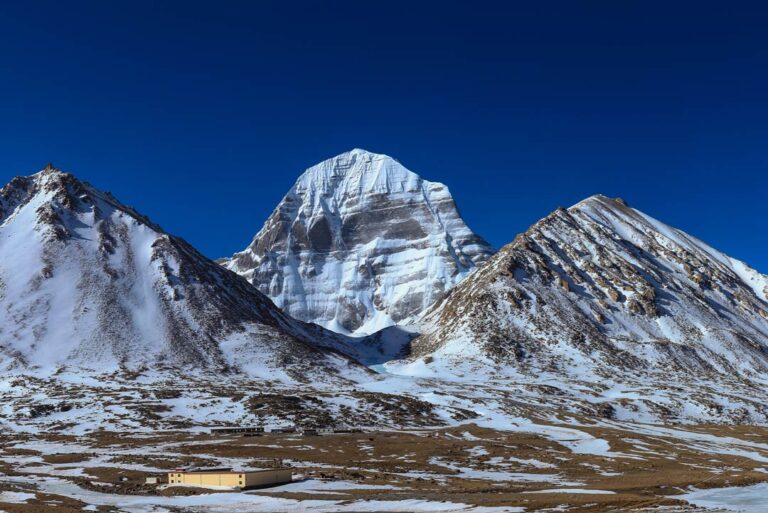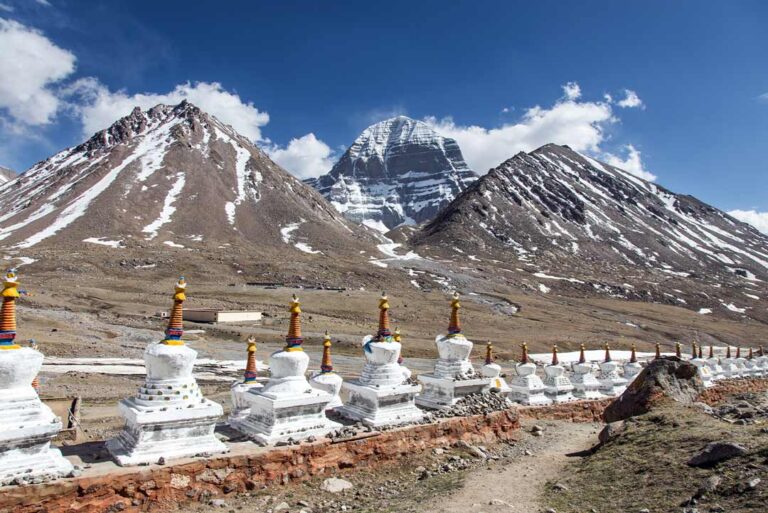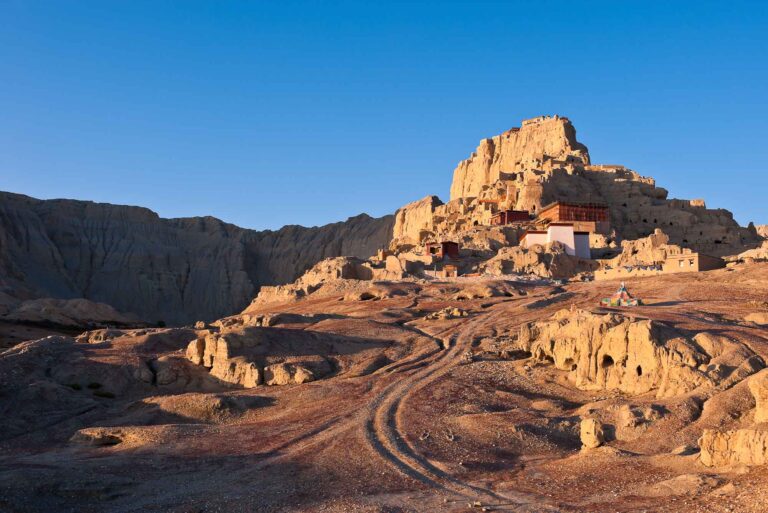Routes to Kailash Mansarovar: The journey to Kailash Mansarovar, a pilgrimage revered by Hindus, Buddhists, Jains, and Bon followers, is a spiritual odyssey filled with mystique and devotion. Pilgrims embarking on this sacred Yatra often face the choice of different routes, each with its own set of challenges, scenic marvels, and cultural significance.
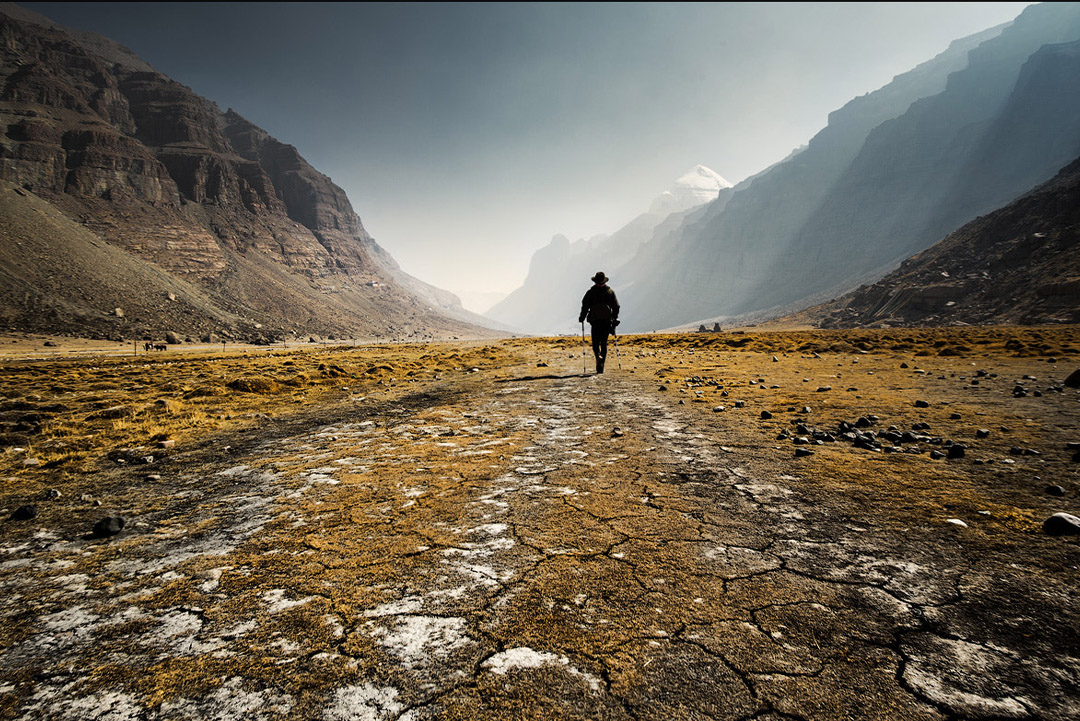
I. Introduction
A. Brief Overview of Kailash Mansarovar Yatra
The Kailash Mansarovar Yatra, beyond being a mere physical journey, transcends into a soul-stirring odyssey, captivating the hearts and minds of pilgrims. This sacred expedition holds profound significance as seekers embark on a quest for blessings, spiritual enlightenment, and the purification of their souls in the ethereal ambiance surrounding Mount Kailash and Lake Mansarovar. The pilgrimage is steeped in spirituality, drawing individuals from diverse faiths, including Hindus, Buddhists, Jains, and Bon followers. Mount Kailash is not just a mountain; it’s a symbol of divinity, a beacon that beckons the devout to experience a transformative connection with the divine. Lake Mansarovar, with its crystal-clear waters, adds to the mystical allure, reflecting the purity and sanctity that pilgrims seek throughout their spiritual sojourn. As aspirants undertake this sacred Yatra, the essence goes beyond the physical challenges, delving into the realms of inner exploration and profound spiritual awakening.
B. Importance of Different Routes for Pilgrims
The importance of selecting the right route becomes paramount in ensuring a truly fulfilling Kailash Mansarovar Yatra, as pilgrims navigate through distinct paths that weave their way to the sacred destination. Each route is a tapestry of unique experiences, becoming a test of the pilgrims’ resilience and unwavering devotion. These diverse paths not only vary in geographical landscapes but also offer cultural and spiritual nuances, adding layers to the pilgrimage experience. The choice of route becomes a personal journey, influenced by individual preferences, geographical considerations, and the desired level of challenge. Delving into the intricacies of the four prominent routes to Kailash Mansarovar, pilgrims embark on a quest that goes beyond physical travel; it becomes a pilgrimage of the soul, a journey where the chosen route is as integral to the experience as the sacred destination itself.
II. Kathmandu – Kyirong – Kailash
A. Starting Point in Kathmandu
Embarking on the Kathmandu – Kyirong – Kailash route, the journey initiates in the bustling heart of Nepal, Kathmandu. This vibrant city becomes the starting point, not just geographically, but spiritually as well, serving as the gateway to the profound expedition that lies ahead. Pilgrims from diverse corners of the globe converge here, creating an atmosphere charged with anticipation and devotion, setting the tone for the transformative odyssey they are about to undertake.
B. Journey Through Kyirong
As pilgrims set forth from Kathmandu, the route unfolds through the picturesque landscapes and valleys of Kyirong. The journey through this region is a visual feast, with breathtaking vistas and high-altitude terrains that challenge the spirit and invigorate the soul. Kyirong, with its tranquil beauty, becomes more than just a waypoint; it becomes a sanctuary where pilgrims connect with nature in its purest form. The landscapes, adorned with towering peaks and serene valleys, serve as both a physical and spiritual backdrop to the pilgrimage.
C. Arrival at Kailash
The culmination of this route is marked by the awe-inspiring arrival at Mount Kailash. As pilgrims approach the sacred peak, a profound sense of reverence and anticipation fills the air. The rituals that follow are deeply ingrained in spiritual significance, with pilgrims engaging in the age-old tradition of circumambulating the majestic mountain. The very act of encircling Kailash is not just a physical endeavor but a symbolic gesture of devotion and spiritual commitment. In these moments, amidst the towering grandeur of Mount Kailash, pilgrims find solace in the divine energy that permeates the surroundings, creating an indelible connection between the earthly and the celestial. Each step in this sacred journey serves as a testament to the pilgrims’ unwavering dedication and the transformative power of the Kailash Mansarovar Yatra.
III. Kathmandu – Simikot – Kailash
A. Initiating the Journey in Kathmandu
An alternative path from Kathmandu, the Kathmandu – Simikot – Kailash route offers pilgrims a distinctive trail to embark upon. The journey kicks off in Kathmandu, much like the more common routes, serving as the initial point of departure for a unique spiritual expedition. This less-trodden path, however, diverges, leading pilgrims to the remote town of Simikot, unveiling a journey that promises its own set of challenges and rewards, distinct from the more frequented routes.
B. Journey Through Kyirong
As pilgrims set forth from Kathmandu, the route unfolds through the picturesque landscapes and valleys of Kyirong. The journey through this region is a visual feast, with breathtaking vistas and high-altitude terrains that challenge the spirit and invigorate the soul. Kyirong, with its tranquil beauty, becomes more than just a waypoint; it becomes a sanctuary where pilgrims connect with nature in its purest form. The landscapes, adorned with towering peaks and serene valleys, serve as both a physical and spiritual backdrop to the pilgrimage.
C. Arrival at Kailash
The culmination of this route is marked by the awe-inspiring arrival at Mount Kailash. As pilgrims approach the sacred peak, a profound sense of reverence and anticipation fills the air. The rituals that follow are deeply ingrained in spiritual significance, with pilgrims engaging in the age-old tradition of circumambulating the majestic mountain. The very act of encircling Kailash is not just a physical endeavor but a symbolic gesture of devotion and spiritual commitment. In these moments, amidst the towering grandeur of Mount Kailash, pilgrims find solace in the divine energy that permeates the surroundings, creating an indelible connection between the earthly and the celestial. Each step in this sacred journey serves as a testament to the pilgrims’ unwavering dedication and the transformative power of the Kailash Mansarovar Yatra.
IV. Kathmandu – Lhasa – Kailash
A. Departure from Kathmandu to Lhasa
The Kathmandu – Lhasa – Kailash route introduces a distinctive facet to the Kailash Mansarovar Yatra, as pilgrims embark on an initial journey to the heart of Tibet – Lhasa. Departing from Kathmandu, the capital of Nepal, the transition to Lhasa becomes more than a geographical shift; it marks a cultural and spiritual bridge. Pilgrims find themselves immersed in the unique blend of Tibetan culture and spirituality, laying the groundwork for a journey that transcends borders and seamlessly fuses diverse influences.
B. Exploring the Route to Kailash
Enroute to Kailash from Lhasa, pilgrims traverse landscapes that bear witness to the seamless fusion of Tibetan landscapes and religious fervor. The journey becomes a tapestry where each step reveals not only the majestic beauty of the terrain but also the profound spiritual currents that run through the very fabric of Tibet. The spiritual richness of Lhasa becomes a guiding force as pilgrims tread towards the sacred destination, creating an experience that is both physically and spiritually enriching.
C. Arrival and Rituals at Kailash
Arriving at Kailash, the culmination of the Kathmandu – Lhasa – Kailash route, pilgrims are greeted by the towering grandeur of the sacred peak. The rituals that unfold here are imbued with a deep connection to the divine. The cultural amalgamation along this route adds a unique flavor to the pilgrimage, as the influences of both Nepalese and Tibetan traditions merge in a celebration of faith. Pilgrims, having traversed the cultural and spiritual tapestry from Kathmandu to Lhasa and finally to Kailash, find themselves not only at the foot of a sacred mountain but at the crossroads of diverse traditions. The rituals become a harmonious symphony of devotion, echoing the cultural journey that brought them to this sacred juncture.
V. Chengdu – Lhasa – Kailash
A. Journey Commencement from Chengdu
The less-traveled Chengdu – Lhasa – Kailash route presents pilgrims with a unique perspective on their spiritual journey. The expedition commences in Chengdu, China, offering a departure point distinct from the more conventional paths. Pilgrims find themselves embarking on an adventure through the heart of China, traversing landscapes that unfold a different chapter of their pilgrimage. The route from Chengdu, less trodden but equally profound, introduces a cultural diversity and geographical richness that sets it apart.
B. Flight to Lhasa
A significant leg of the journey involves a flight to Lhasa, a city where Chinese and Tibetan cultures converge. This airborne transition becomes a metaphorical bridge between diverse influences, creating a cultural tapestry that enriches the overall pilgrimage experience. Pilgrims, in this part of the journey, witness the juxtaposition of the modernity of Chinese cities and the ancient spiritual traditions of Tibet, offering a harmonious blend of contrasting yet complementary elements.
C. Reaching Kailash Overland and Its Significance
The final stretch of the journey involves reaching Kailash overland, marking the culmination of the Chengdu – Lhasa – Kailash route. The arrival at Kailash, after traversing diverse terrains and cultural landscapes, is a moment of profound accomplishment. Pilgrims, having overcome the challenges presented by the unique combination of Chinese and Tibetan influences, stand in the shadows of the sacred peak, finding not just physical fulfillment but a deep sense of spiritual satisfaction. The significance of this route lies not only in its less-explored nature but in the amalgamation of diverse experiences that shape the narrative of the pilgrims’ transformative journey to the heart of Kailash Mansarovar. Each step, from Chengdu to Lhasa and finally to Kailash, is a testament to the pilgrims’ resilience, cultural openness, and unwavering devotion.
VI. Factors Influencing the Choice of Route
A. Pilgrim Preferences
One of the pivotal factors in determining the route to Kailash Mansarovar is the individual preferences of the pilgrims themselves. Each seeker embarking on this spiritual journey brings a unique set of expectations and desires. Some are drawn to the allure of the less-traveled routes, seeking the road less explored for a more intimate and authentic experience. On the other hand, some pilgrims find solace in the familiarity of well-trodden paths, where the footsteps of countless predecessors echo with spiritual resonance. The choice becomes a deeply personal one, reflecting the pilgrim’s inner quest and the type of experience they aspire to undergo on their way to Kailash.B. Geographical Considerations
The diverse landscapes and altitudes encountered along each route present pilgrims with a spectrum of challenges and scenic wonders. Geographical considerations become a crucial aspect influencing the choice of route. Pilgrims must weigh not only the physical preparedness required for navigating different terrains but also their comfort levels amidst varying altitudes. Whether it be the lush valleys of Kyirong, the remote town of Simikot, the ancient city of Lhasa, or the heart of China starting from Chengdu, each route unfolds a unique topographical story. Pilgrims, mindful of their own limitations and aspirations, carefully consider these geographical aspects to ensure a pilgrimage that aligns with both their spiritual and physical capacities.
C. Duration and Difficulty Levels
The time and effort demanded by each route differ significantly, becoming another pivotal factor in the decision-making process for pilgrims. Some may have the luxury of a more extended timeframe, allowing them to choose routes that involve more arduous and challenging terrains. Others, constrained by time or physical limitations, may opt for routes with a shorter duration and comparatively less difficulty. Pilgrims embark on this sacred journey with a spectrum of capabilities and constraints, and the consideration of duration and difficulty levels becomes a crucial aspect of planning. Each route, whether demanding or more accessible, offers its own set of transformative experiences, ensuring that the pilgrims’ choices align harmoniously with their unique journey to Kailash Mansarovar.VII. Cultural and Scenic Highlights
A. Unique Cultural Experiences on Each Route
The Kailash Mansarovar Yatra is not merely a physical pilgrimage but a cultural odyssey, and each route unveils a unique chapter in this journey of cultural revelation. From the bustling markets of Kathmandu to the serene monasteries of Tibet, every step along the pilgrimage is a portal into diverse and vibrant cultures. In Kathmandu, pilgrims are immersed in the kaleidoscope of Nepalese traditions, with the city serving as a melting pot of Hindu and Buddhist influences. As the journey progresses, the transition to Tibet introduces a different cultural palette, marked by the timeless beauty of Tibetan monasteries and the enchanting rituals embedded in the local way of life. Pilgrims, thus, become cultural ambassadors, traversing not only geographical distances but also cultural landscapes, each step bringing them closer to the heart of Kailash.B. Scenic Landscapes and Attractions
The landscapes encountered on the Kailash Mansarovar Yatra are not merely a backdrop but an integral part of the spiritual narrative, offering pilgrims visual feasts that enhance the depth of their journey. The lush valleys of Kyirong, adorned with pristine beauty, serve as a prelude to the scenic marvels that unfold. As pilgrims traverse through these valleys, nature’s grandeur becomes a silent companion, elevating the spiritual experience. Moving forward, the arid terrains of Tibet, with their stark beauty and vast expanses, create a contrasting yet equally captivating backdrop. Each route, whether through the verdant landscapes or the rugged terrains, paints a canvas of awe-inspiring scenic beauty. These natural wonders become more than just sights to behold; they become reflections of the divine, inviting pilgrims to connect not only with their inner selves but also with the profound beauty of the world around them. The Kailash Mansarovar Yatra, with its cultural and scenic highlights, is a holistic journey that enriches the spirit through a tapestry of diverse cultures and the breathtaking beauty of the natural world.
VIII. Preparing for the Kailash Mansarovar Yatra
A. Essential Preparations for the Journey
Undertaking the Kailash Mansarovar Yatra is not just a spiritual calling; it’s a physical and mental expedition that demands meticulous preparations. Pilgrims, before embarking on this challenging journey, must ensure that they are physically and mentally ready for the trials that await. Essential preparations involve cultivating adequate fitness levels, understanding the demands of the terrain, and gearing up for the arduous trek that lies ahead. Proper gear, tailored to withstand varying climates and terrains, becomes the pilgrim’s armor against the elements. Mental resilience is equally imperative, as the Yatra, beyond its physical challenges, tests the inner strength and determination of every pilgrim.B. Health Considerations and Precautions
The high altitudes encountered during the Kailash Mansarovar Yatra necessitate heightened attention to health considerations. Pilgrims are advised to acclimatize gradually, allowing their bodies to adjust to the reduced oxygen levels. Staying hydrated becomes a mantra for combating altitude-related challenges, and pilgrims are encouraged to be vigilant about their water intake. Awareness of symptoms related to altitude sickness, such as nausea and dizziness, is crucial, empowering pilgrims to take timely precautions. Health considerations extend beyond the physical, delving into the mental and emotional well-being of the pilgrims, emphasizing the holistic nature of the preparations.C. Permits and Documentation
Navigating the bureaucratic requirements is a pragmatic aspect of preparing for the Kailash Mansarovar Yatra. Pilgrims must ensure they have all the necessary permits and documentation in place to avoid any hindrance during the journey. This involves meticulous attention to detail, ensuring that paperwork is complete, up-to-date, and aligned with the regulatory requirements of both Nepal and China. The pilgrimage involves crossing international borders and sacred territories, making the adherence to permit and documentation procedures a critical aspect of the pre-journey preparations. Pilgrims, armed with the right permits, embark on the Yatra with a sense of assurance, knowing that the logistical aspects are in order, allowing them to focus entirely on the spiritual dimensions of the pilgrimage. The preparation for the Kailash Mansarovar Yatra, therefore, is a multi-faceted endeavor that combines physical readiness, health consciousness, and bureaucratic diligence, ensuring a smoother and more fulfilling journey to the sacred destination.IX. Personal Experiences
A. Narratives from Pilgrims on Different Routes
The Kailash Mansarovar Yatra is not just a collective journey but a tapestry woven with the personal narratives of countless pilgrims, each route painting a unique chapter in their stories. Real-life experiences shared by pilgrims who have undertaken different routes offer invaluable insights into the diverse challenges and joys encountered along the way. These narratives become a source of guidance for future aspirants, providing a firsthand account of the realities of the pilgrimage. Whether it be the cultural revelations in Kathmandu, the intimate encounters in Simikot, the spiritual transitions in Lhasa, or the cultural amalgamation starting from Chengdu, each story contributes to the collective wisdom of the Kailash Mansarovar Yatra.
B. Challenges and Triumphs
Every route to Kailash Mansarovar unfolds a narrative of challenges and triumphs, a testament to the indomitable spirit of pilgrims who brave the arduous paths. The challenges are diverse, ranging from the physical rigors of high altitudes to the cultural adjustments in unfamiliar terrains. Pilgrims, however, do not merely recount the difficulties faced; they share tales of triumph over adversity, both physical and spiritual. The joy of reaching Kailash is not just a geographical milestone but a spiritual victory, a culmination of resilience, faith, and determination. These stories of triumph become a wellspring of inspiration for those yet to embark on their pilgrimage, proving that every challenge surmounted along the route becomes a stepping stone towards the profound spiritual fulfillment that awaits at the foot of Mount Kailash. The personal experiences shared by pilgrims add depth to the collective narrative of the Kailash Mansarovar Yatra, turning it into a mosaic of individual journeys, each contributing to the larger tapestry of spiritual exploration and conquest.X. Spiritual Significance
A. Spiritual Aspects of the Kailash Mansarovar Yatra
Beyond the tangible landscapes and the physical trials, the Kailash Mansarovar Yatra transcends into a profound spiritual pilgrimage. Pilgrims, with each step towards Mount Kailash, embark on a journey that delves deep into the spiritual realms of their being. The Yatra becomes a sacred communion, a direct connection with the divine. Amidst the breathtaking vistas and cultural diversities, pilgrims find solace in the quietude of their inner selves. The Yatra is not just about reaching a destination; it’s about seeking inner peace, enlightenment, and a spiritual awakening that resonates long after the physical journey concludes. Mount Kailash, revered across multiple faiths, becomes more than a geographical peak; it transforms into a spiritual beacon, guiding the seekers towards a higher state of consciousness.
B. Insights from Religious Texts
The spiritual significance of the Kailash Mansarovar Yatra is not a recent revelation but a timeless truth echoed in ancient religious texts. Scriptures from Hinduism, Buddhism, Jainism, and the Bon tradition extol the sanctity of this sacred journey. The Vedas describe Mount Kailash as the center of the universe, an abode of Lord Shiva. Buddhist texts consider it a sacred dwelling of Buddha Demchok. Jain scriptures mention it as the site where the first Tirthankara achieved enlightenment, and the Bon tradition regards it as the seat of spiritual power. These insights from religious texts add a profound layer to the pilgrims’ understanding, imbuing the journey with a sense of divine purpose. The Yatra, viewed through the lens of ancient wisdom, becomes a pilgrimage not just to a physical location but to the very essence of spirituality, where the seeker and the sacred merge into a harmonious union. As pilgrims absorb the spiritual significance derived from both personal experiences and ancient scriptures, the Kailash Mansarovar Yatra becomes a holistic voyage, transforming the outer landscapes and inner landscapes alike.XI. Tips for a Fulfilling Yatra
A. Practical Tips for a Successful Pilgrimage
Embarking on the Kailash Mansarovar Yatra is not only a spiritual endeavor but also a physical and logistical challenge. Practical tips play a pivotal role in ensuring a successful pilgrimage. Choosing the right footwear, for instance, becomes crucial as pilgrims navigate diverse terrains. The terrain varies from the lush valleys of Kyirong to the arid landscapes of Tibet, demanding footwear that can withstand the rigors of both. Managing altitude sickness is another practical consideration, requiring pilgrims to acclimatize gradually, stay hydrated, and be vigilant about symptoms. Packing essentials, such as weather-appropriate clothing, medications, and portable oxygen, adds a layer of preparedness to the journey. Practical tips, garnered from the experiences of seasoned pilgrims, become a valuable compass for those venturing into the spiritual landscapes of Kailash.B. Dos and Don’ts During the Yatra
Responsible pilgrimage involves not only personal preparedness but also a conscious effort to respect local customs, conserve the environment, and adhere to safety guidelines. Dos include respecting the sanctity of the religious sites, being mindful of local traditions, and fostering a spirit of camaraderie with fellow pilgrims. On the flip side, don’ts encompass refraining from littering, avoiding disturbances during religious rituals, and respecting the ecological balance of the region. Conservation of the pristine landscapes becomes a collective responsibility, ensuring that the spiritual footprints left behind are harmonious with the natural beauty of the surroundings. Safety guidelines, both for personal well-being and the well-being of others, become imperative, emphasizing the need for responsible and respectful conduct throughout the Yatra. Dos and don’ts, as guiding principles, ensure that the pilgrimage is not only fulfilling on a personal level but also contributes positively to the cultural and environmental ethos of the sacred journey.
XII. Kailash Yatra Co. – A Trusted Companion
A. Introduction to Kailash Yatra Co.
In the intricate tapestry of the Kailash Mansarovar Yatra, choosing the right travel companion is paramount. Kailash Yatra Co. emerges as a beacon, standing out as a trusted partner in facilitating a seamless and enriching pilgrimage experience. With a commitment to ensuring that every pilgrim’s spiritual journey is not only transformative but also free from logistical complexities, Kailash Yatra Co. becomes more than a travel agency; it becomes a guiding force, navigating the spiritual seekers through the sacred terrains with expertise and dedication. The importance of a reliable travel companion cannot be overstated, and Kailash Yatra Co. steps into this role with a legacy of trust and a reputation for excellence, establishing itself as a companion of choice for those embarking on the sacred journey to Kailash Mansarovar.
B. Services Offered to Pilgrims
Kailash Yatra Co. goes beyond conventional travel agencies, providing a comprehensive array of services that cater to the unique needs of pilgrims on their spiritual odyssey. From meticulous travel arrangements, including transportation and accommodation, to the provision of knowledgeable guides well-versed in the spiritual and historical significance of the pilgrimage, Kailash Yatra Co. ensures that every aspect of the journey is attended to with care and precision. Pilgrims, entrusted to the capable hands of Kailash Yatra Co., can focus wholeheartedly on the spiritual aspects of their journey, knowing that the logistical intricacies are managed with expertise. The agency’s commitment to delivering not just a pilgrimage but an immersive spiritual experience sets it apart, making it a reliable companion for those who seek the divine in the shadow of Mount Kailash. With Kailash Yatra Co. as a guiding partner, pilgrims can embark on their spiritual sojourn with confidence, knowing that their quest for Kailash Mansarovar is in the hands of professionals dedicated to ensuring a transformative and fulfilling pilgrimage.XIII. Conclusion Routes to Kailash Mansarovar
A. Recapitulation of Routes and Their Uniqueness
In the culmination of this exploration into the sacred realms of Kailash Mansarovar, the diverse routes unfurl as distinct paths, each laden with its own tapestry of unique experiences. From the vibrant cultural encounters in Kathmandu to the serene landscapes of Kyirong, from the remote charm of Simikot to the spiritual transitions in Lhasa, and from the heart of China starting in Chengdu to the less-traveled landscapes on the way to Mount Kailash, each route becomes more than a geographical trajectory—it transforms into a personal journey. The recapitulation of these routes serves as a compass for aspiring pilgrims, offering a glimpse into the multifaceted nature of the pilgrimage and affirming that the choice of route is not merely a logistical decision but a profound step in the pilgrim’s quest for spiritual fulfillment. The Kailash Mansarovar Yatra, viewed through the lens of these diverse routes, emerges as a kaleidoscope of experiences, inviting seekers to traverse not only geographical distances but also the landscapes of their own souls.
B. Encouragement for Embarking on the Spiritual Journey
As we draw the curtains on this exploration of the routes to Kailash Mansarovar, an invitation echoes through the spiritual winds—an encouragement for aspirants to embark on this transformative journey. The Kailash Mansarovar Yatra is not just a pilgrimage; it’s a profound odyssey that transcends the physical and ventures into the realms of the spiritual. The challenges encountered along the way become gateways to revelations, and the sacred destination, Mount Kailash, beckons with the promise of inner peace and enlightenment. Aspirants are encouraged to embrace the uncertainties, to tread the path less traveled, and to find solace in the divine aura that envelops Kailash and Mansarovar. The Yatra is not merely a destination; it’s an opportunity for spiritual rejuvenation, a chance to connect with the divine in a way that resonates long after the footprints have faded. With each step towards Kailash, pilgrims become part of a timeless tradition, contributing their unique stories to the rich tapestry of the Kailash Mansarovar Yatra. As the call to embark on this spiritual odyssey reverberates, may every seeker find the courage to journey within and without, discovering the profound depths that await in the shadow of Mount Kailash.
FAQs on Routes to Kailash Mansarovar:
1) How Long Does the Kailash Mansarovar Yatra Usually Take?
The temporal dimension of the Kailash Mansarovar Yatra is a query often pondered by aspirants. The journey’s duration is diverse, yet a standard Yatra typically spans around 15 to 20 days. This timeframe encompasses travel to the starting point, the sacred rituals, circumambulation of Mount Kailash, and the return journey. The fluidity in duration caters to the multifaceted nature of the pilgrimage, acknowledging that each pilgrim’s spiritual journey unfolds at its own pace amidst the timeless landscapes of Kailash.
2) Are There Age Restrictions for the Pilgrimage?
The prospect of age restrictions is a common concern among those drawn to the sacred pilgrimage. While there is no stringent age limit, prospective pilgrims are advised to gauge their physical fitness judiciously. The challenging terrains demand a certain level of endurance, and individuals, regardless of age, should be adequately prepared to navigate the varying altitudes and landscapes encountered along the pilgrimage.
3) What Is the Best Time to Undertake the Yatra?
Discerning the opportune moment to embark on the Kailash Mansarovar Yatra is crucial for a fulfilling experience. The optimal time aligns with the summer months, spanning from May to September. During this period, the weather conditions are favorable, offering a more comfortable pilgrimage experience. The landscapes reveal their full splendor, with lush valleys and clear skies enhancing the spiritual journey.
4) Can I Customize My Travel Package with Kailash Yatra Co.?
The prospect of tailoring the pilgrimage to individual preferences is a pertinent consideration for seekers. Kailash Yatra Co., cognizant of the diverse aspirations of pilgrims, offers customizable packages. This flexibility allows pilgrims to align their travel experience with personal preferences and requirements, ensuring a pilgrimage that resonates with their unique spiritual journey.
5) How Does Kailash Yatra Co. Ensure the Safety of Pilgrims?
Safety is paramount in the sacred landscapes of Kailash, and entrusting this responsibility to Kailash Yatra Co. instills confidence in pilgrims. The agency prioritizes safety through a comprehensive approach, including experienced guides well-versed in the terrain, medical support, and strict adherence to safety protocols. This commitment ensures that every participant in the pilgrimage experiences not only spiritual enrichment but also a secure and protected journey guided by the expertise of Kailash Yatra Co.

